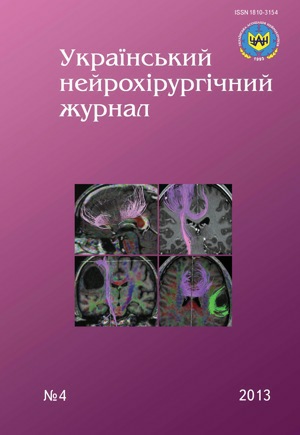Secondary changes in spinal cord due to prolonged compression at trauma of cervical spine
DOI:
https://doi.org/10.25305/unj.55416Keywords:
spinal trauma, secondary trauma, oedema, ischemia, neuroinflammation, excitotoxicity, apoptosisAbstract
Introduction. One of the reasons for secondary changes in spinal cord at spinal trauma — is it’s tissue alteration by vertebrae bone fragments and dura mater. Study of morphogenesis in tissues of damaged spinal cord in different periods of trauma let us to estimate severity of secondary alterations and influence of early decompression.
Materials and methods. Comparative morphological study of macro- and micropreparations in 4 patients, died because of cervical spine contusion on the 4, 8, 10th and 71st day was provided.
Results. Secondary alterations in spinal cord at prolonged compression were revealed. Secondary trauma is less expressed after early decompression performing.
Conclusions. 1. The initial trauma of the spinal cord at prolonged compression is accompanied by progressive secondary changes of it’s tissue — ischemia, oedema, inflammation, and as a consequence by irreversible changes of spinal cord structure and function. 2. Early surgery may prevent secondary alteration spreading and is promising in treatment of such patients.References
1. Polishchuk NYe, Korzh NA, Fishchenko VYa. Povrezhdeniya pozvonochnika i spinnogo mozga [Spine and spinal cord damages]. Kiev: Kniga plyus; 2001. Russian.
2. Slynko YeI, Khonda AN. Travmaticheskiye povrezhdeniya pozvonochnika i spinnogo mozga [Spine and spinal cord traumatic injuries]. Kiev: PP Gamma-Print; 2010. Russian.
3. Tsymbalyuk V, Khonda O, Avad M. Travmatychni urazhennya khrebta i spynnoho mozku [Traumatic lesions of the spine and spinal cord]. In: Tsymbalyuk V, Khonda O, Tretyak I, Avad M, editors. Neyrokhirurhiya: kurs lektsiy [Neurosurgery: lectures]. Kiev: Alkon; 2002. Ukrainian.
4. Tsymbalyuk VI, Yamins’kyy YuYa. Rekonstruktyvno-vidnovna khirurhiya spynnoho mozku [Reconstructive surgery of the spinal cord]. Kiev: Avitsena; 2009. Ukrainian.
5. Choo AM, Liu J, Lam CK, Dvorak M, Tetzlaff W, Oxland TR. Contusion, dislocation, and distraction: primary hemorrhage and membrane permeability in distinct mechanisms of spinal cord injury. J Neurosurg Spine. 2007 Mar;6(3):255-66. [CrossRef] [PubMed]
6. Tator CH1, Fehlings MG.Review of the secondary injury theory of acute spinal cord trauma with emphasis on vascular mechanisms. J Neurosurg. 1991. Jul;75(1):15-26. [CrossRef] [PubMed]
7. Li S, Mealing GA, Morley P, Stys PK. Novel injury mechanism in anoxia and trauma of spinal cord white matter: glutamate release via reverse Na+-dependent glutamate transport. J Neurosci. 1999 Jul 15;19(14):16. [PubMed]
8. Nashmi R, Fehlings MG. Changes in axonal physiology and morphology after chronic compressive injury of the rat thoracic spinal cord. Neuroscience. 2001;104(1):235-51. [CrossRef] [PubMed]
9. Tator CH. Update on the pathophysiology and pathology of acute spinal cord injury. Brain Pathol. 1995 Oct;5(4):407-13. [CrossRef] [PubMed]
10. Donnelly DJ, Popovich PG. Inflammation and its role in neuroprotection, axonal regeneration and functional recovery after spinal cord injury. Exp Neurol. 2008 Feb;209(2):378-88. [CrossRef] [PubMed]
11. Shechter R, London A, Varol C, Raposo C, Cusimano M, Yovel G, Rolls A, Mack M, Pluchino S, Martino G, Jung S, Schwartz M. Infiltrating blood-derived macrophages are vital cells playing an anti-inflammatory role in recovery from spinal cord injury in mice. PLoS Med. 2009 Jul;6(7):e1000113. [CrossRef] [PubMed]
12. Shechter R, Raposo C, London A, Sagi I, Schwartz M. The glial scar-monocyte interplay: a pivotal resolution phase in spinal cord repair. PLoS One. 2011;6(12):e27969. [CrossRef] [PubMed]
13. Ackery A, Robins S, Fehlings MG. Inhibition of Fas-mediated apoptosis through administration of soluble Fas receptor improves functional outcome and reduces posttraumatic axonal degeneration after acute spinal cord injury. J Neurotrauma. 2006;23(5):604-16. [CrossRef]
14. Cregan SP, Dawson VL, Slack RS. Role of AIF in caspase-dependent and caspase-independent cell death. Oncogene. 2004 Apr 12;23(16):2785-96. [CrossRef] [PubMed]
15. Brazda N, Müller HW. Pharmacological modification of the extracellular matrix to promote regeneration of the injured brain and spinal cord. Prog Brain Res. 2009;175:269-81. [CrossRef] [PubMed]
16. Buss A, Pech K, Kakulas BA, Martin D, Schoenen J, Noth J, Brook GA. NG2 and phosphacan are present in the astroglial scar after human traumatic spinal cord injury. BMC Neurol. 2009 Jul 15;9:32. [CrossRef] [PubMed]
17. Shen Y, Tenney AP, Busch SA, Horn KP, Cuascut FX, Liu K, He Z, Silver J, Flanagan JG. PTPsigma is a receptor for chondroitin sulfate proteoglycan, an inhibitor of neural regeneration. Science. 2009 Oct 23;326(5952):592-6. [CrossRef] [PubMed]
18. Burney RE, Maio RF, Maynard F, Karunas R. Incidence, characteristics, and outcome of spinal cord injury at trauma centers in North America. Arch Surg. 1993 May;128(5):596-9. [CrossRef] [PubMed]
19. Fehlings MG, Vaccaro A, Wilson JR, Singh AW, Cadotte D, Harrop JS, Aarabi B, Shaffrey C, Dvorak M, Fisher C, Arnold P, Massicotte EM, Lewis S, Rampersaud R. Early versus delayed decompression for traumatic cervical spinal cord injury: results of the Surgical Timing in Acute Spinal Cord Injury Study (STASCIS). PLoS One. 2012;7(2):e32037. [CrossRef] [PubMed]
Downloads
Published
How to Cite
Issue
Section
License
Copyright (c) 2013 Vitaliy Tsymbaliuk, Waldemar Nevodnik, Mykola Salkov

This work is licensed under a Creative Commons Attribution 4.0 International License.
Ukrainian Neurosurgical Journal abides by the CREATIVE COMMONS copyright rights and permissions for open access journals.
Authors, who are published in this Journal, agree to the following conditions:
1. The authors reserve the right to authorship of the work and pass the first publication right of this work to the Journal under the terms of Creative Commons Attribution License, which allows others to freely distribute the published research with the obligatory reference to the authors of the original work and the first publication of the work in this Journal.
2. The authors have the right to conclude separate supplement agreements that relate to non-exclusive work distribution in the form of which it has been published by the Journal (for example, to upload the work to the online storage of the Journal or publish it as part of a monograph), provided that the reference to the first publication of the work in this Journal is included.









